4-5 The Sun and planets formed from a rotating solar nebula
How did the Sun and planets form? Where did the solar system come from? These questions have tantalized astronomers for centuries. The first step toward answers lies with an understanding of which elements are most abundant in our solar system and beyond. For a summary of the properties of all the planets, see Cosmic Connections: Characteristics of the Planets.
The Origin of the Elements and Cosmic “Recycling”
As we saw earlier in the chapter, one of the key properties of our solar system is that the inner, terrestrial planets are smaller and made of much heavier chemical elements than the significantly larger outer planets, which are made of relatively lightweight elements. One reason for this fundamental difference is that the chemical elements of hydrogen and helium are quite common in the universe, while the heavier elements that make up rocky substances are quite rare.
The dominance of hydrogen and helium is not merely a characteristic of the outer reaches of our solar system. By analyzing the spectra of stars and galaxies outside our solar system, astronomers have found essentially the same pattern of chemical abundances out to the farthest distance attainable by the most powerful telescopes. Hence, the vast majority of the atoms in the universe are hydrogen and helium atoms. The elements that make up the bulk of Earth—mostly iron, oxygen, and silicon—are relatively rare in the universe as a whole, as are the elements of which living organisms are made—carbon, oxygen, nitrogen, and phosphorus, among others.
There is a good reason for this overwhelming abundance of hydrogen and helium. A wealth of evidence has led astronomers to conclude that the universe began some 13.7 billion years ago with a violent event known as the Big Bang. Only the lightest elements—hydrogen and helium, as well as tiny amounts of lithium and perhaps beryllium—emerged from the enormously high temperatures following this cosmic event. All the heavier elements were manufactured by stars later, either by the combining of lighter atoms together into heavier atoms deep in their interiors or by the violent explosions that mark the end of massive stars. Were it not for these processes, which take place only in stars, there would be no heavy elements in the universe, no planet like our Earth, and no humans to contemplate the nature of the cosmos.
Because our solar system contains heavy elements, it must be that at least some of its material was once inside other stars. But how did this material become available to help build our solar system? The answer is that near the ends of their lives, stars cast much of their matter back out into space. For most stars this process is a comparatively gentle one, in which a star’s outer layers are gradually expelled. Figure 4-9 shows a star losing material in this fashion. This ejected material appears as the cloudy region that surrounds the star and is illuminated by it. A few stars eject matter much more dramatically at the very end of their lives, in a spectacular detonation called a supernova, which blows the star apart.
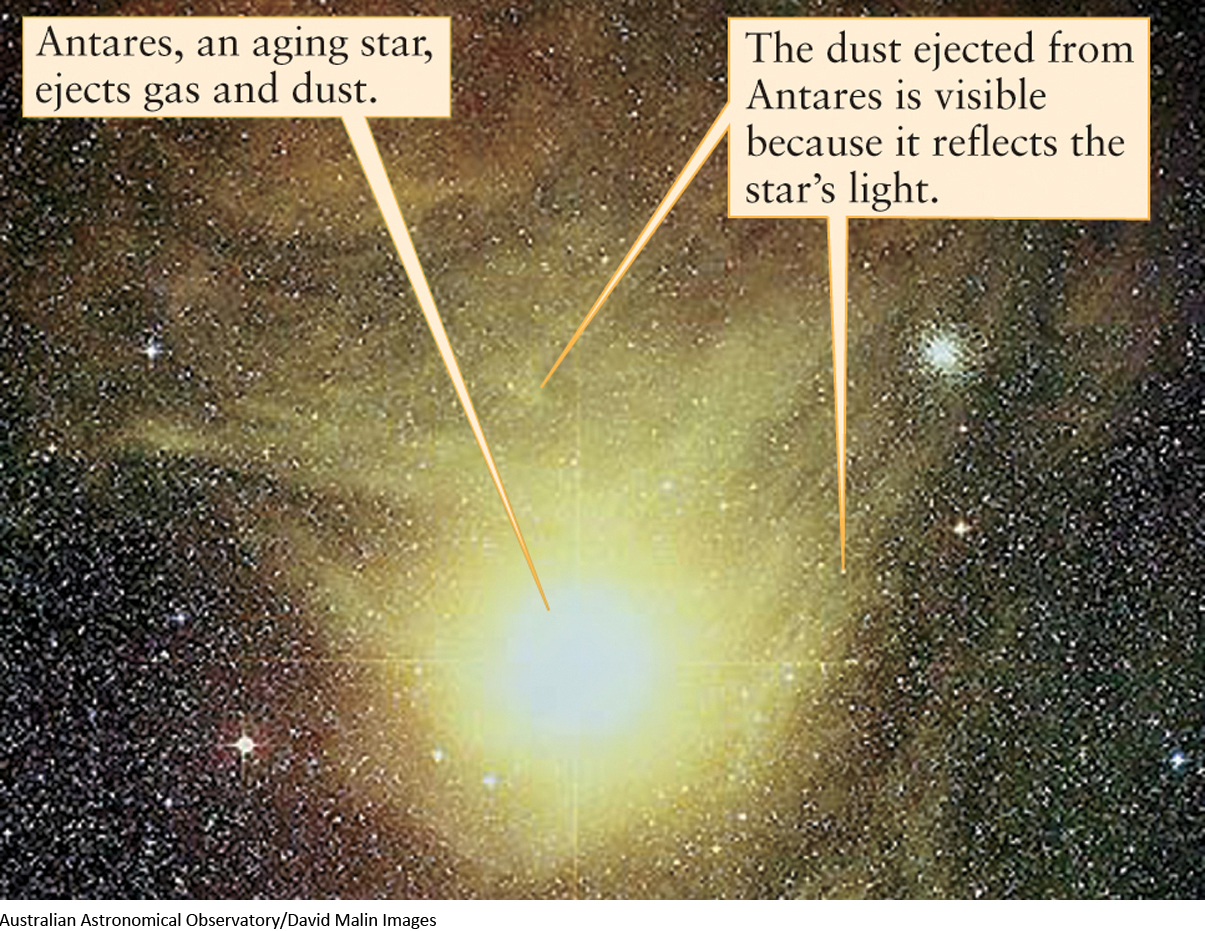
98
COSMIC CONNECTIONS Characteristics of the Planets
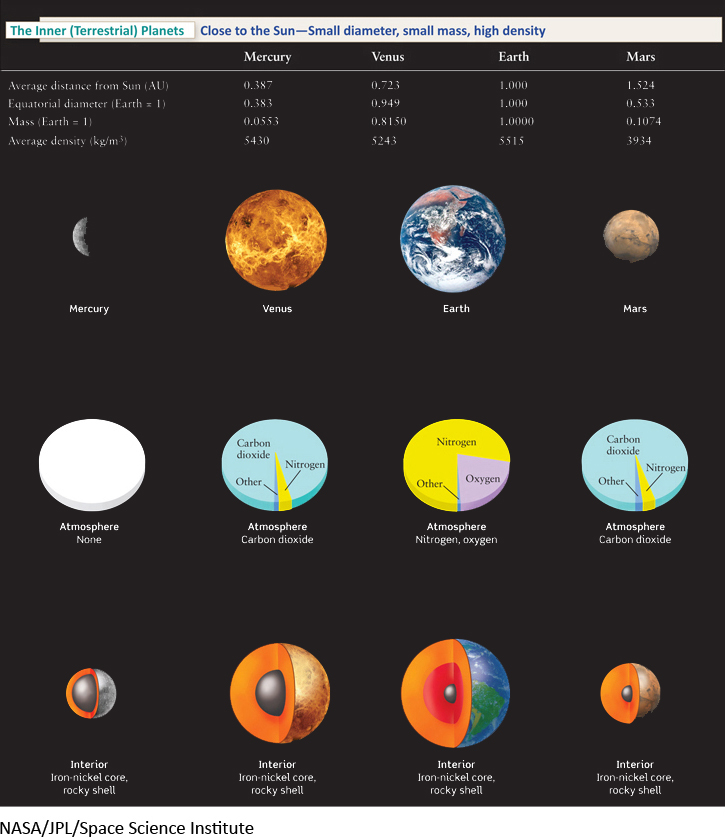
99
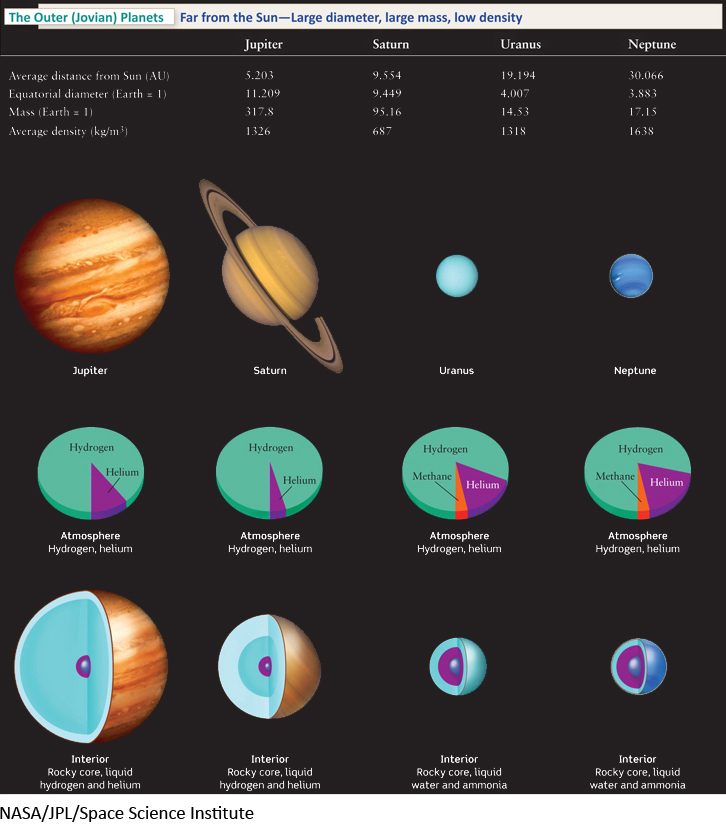
100
No matter how it escapes, the ejected material contains heavy elements from which to develop a system of planets, moons, comets, and asteroids. Our own solar system must have formed from enriched material in just this way. Thus, our solar system contains “recycled” material that was produced long ago inside a now-dead star. This “recycled” material includes all of the carbon in your body, all of the oxygen that you breathe, and all of the iron and silicon in the soil beneath your feet.
Question
ConceptCheck 4-11: To what does the phrase “we are all made of star stuff” refer?
The Birth of the Sun: The Solar Nebular Hypothesis
Our star, the Sun, did not produce the elements that make up our solar system. These raw materials were first created during the Big Bang and then later in processes within ancient stars that have long since disappeared. But given these ingredients, how might they have combined to make the Sun and planets we see today? Whatever description we devise must account for the two broad categories of planets as well as the shape and rotation of the solar system itself.
The central idea agreed upon by most astronomers dates to the late 1700s, when the German philosopher Immanuel Kant and the French scientist Pierre-Simon de Laplace turned their attention to the manner in which the planets orbit the Sun. Both concluded that the arrangement of the orbits—all in the same direction and in nearly the same plane—could not be mere coincidence. To explain the orbits, Kant and Laplace independently proposed that our entire solar system, including the Sun as well as all of its planets and moons, formed from a vast, rotating cloud of gas and dust called the solar nebula (Figure 4-10). This explanation is called the nebular hypothesis.
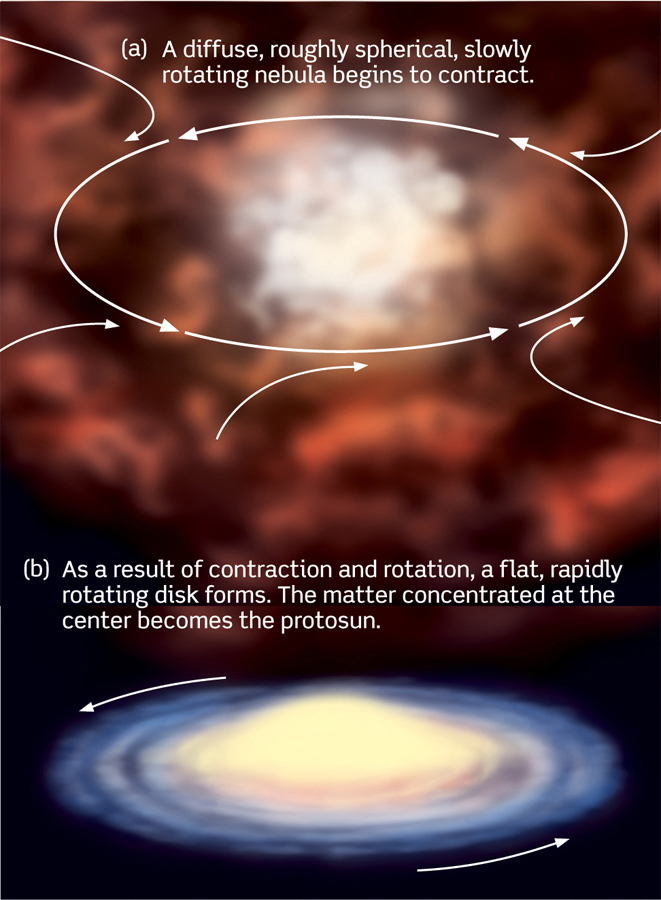
Each part of the nebula exerted a gravitational attraction on the other parts, and these mutual gravitational pulls tended to make the nebula contract. As it contracted, the greatest concentration of matter occurred at the center of the nebula, forming a relatively dense region called the protosun. As its name suggests, this part of the solar nebula eventually developed into the Sun. The planets formed from the much sparser material in the outer regions of the solar nebula. Indeed, the mass of all the planets together is only 0.1% of the Sun’s mass.
When you drop a ball, the gravitational attraction of Earth makes the ball fall faster and faster as it falls; in the same way, material falling inward toward the protosun would have gained speed as it fell. When this fast-moving material slammed into the protosun, the energy of the collision was converted into thermal energy, causing the temperature deep inside the solar nebula to increase.
We will cover the Sun in detail in Chapter 9, but for now there are a few things you need to know about the Sun in the context of the formation of the solar system. The key thing to remember is that our solar system formed at nearly the same time as the Sun did. What happens is, as our newly created protosun contracted from its initial solar nebula, its interior temperature dramatically increased as well. About 105 (100,000) years after it began to form, the protosun’s surface temperature stabilized at about 6000 K, but the temperature in its interior kept increasing to ever higher values as the central regions of the contracting protosun became denser and denser. Eventually, perhaps 107 (10 million) years after the solar nebula first began to contract, the gas at the center of the protosun reached a density of about 105kg/m3 (a hundred times denser than water) and a temperature of a few million kelvins (that is, a few times 106K). Under these extreme conditions, nuclear reactions that convert hydrogen into helium began in the protosun’s interior. When this happened, the energy released by these reactions stopped the contraction and a true star was born. Nuclear reactions continue to the present day in the interior of the Sun and are the source of all the energy that the Sun radiates into space.
If the solar nebula had not been rotating at all, everything would have fallen directly into the protosun, leaving nothing behind to form the planets. Instead, the solar nebula must have had an overall slight rotation, which caused its evolution to follow a different path. As the slowly rotating nebula collapsed inward, it would naturally have tended to rotate faster. This relationship between the decreasing size of an object and its increasing rotation speed is an example of a general principle called the conservation of angular momentum.
101
ANALOGY
Figure skaters make use of the conservation of angular momentum. When a spinning skater pulls her arms and legs in close to her body, the rate at which she spins automatically increases (Figure 4-11). Even if you are not a figure skater, you can demonstrate this by sitting on an office chair. Sit with your arms outstretched and hold a weight, like a brick or a full water bottle, in either hand. Now use your feet to start your body and the chair rotating, lift your feet off the ground, and then pull your arms inward. Your rotation will speed up quite noticeably.

As the solar nebula began to rotate more rapidly, it also tended to flatten out (see Figure 4-10b). From the perspective of a particle rotating along with the nebula, it felt as though there were a force pushing the particle away from the nebula’s axis of rotation. (Likewise, passengers on a spinning carnival ride seem to feel a force pushing them outward and away from the ride’s axis of rotation.) This apparent force was directed opposite to the inward pull of gravity, and so it tended to slow the contraction of material toward the nebula’s rotation axis. But there was no such effect opposing contraction in a direction parallel to the rotation axis. Some 105 (100,000) years after the solar nebula first began to contract, it had developed the structure shown in Figure 4-10b, with a rotating, flattened disk surrounding what became the protosun. This disk is called the protoplanetary disk, or proplyd, since planets formed from its material. This model explains why their orbits all lie in essentially the same plane and why they all orbit the Sun in the same direction.
There were no humans to observe these processes taking place during the formation of the solar system. But Earth astronomers have seen disks of material surrounding other stars that formed only recently. These, too, are called protoplanetary disks, because it is thought that planets can eventually form from these disks around other stars. Hence, these disks are planetary systems that are still “under construction.” By studying these disks around other stars, astronomers are able to examine what our solar nebula may have been like some 4.56 × 109 years ago.
Figure 4-12 shows a number of protoplanetary disks in the Orion Nebula, a region of active star formation. A study of 110 young stars in the Orion Nebula detected protoplanetary disks around 56 of them, which suggests that systems of planets may form around a substantial fraction of stars. Later in this chapter we will see direct evidence for planets that have formed and orbit around stars other than the Sun.
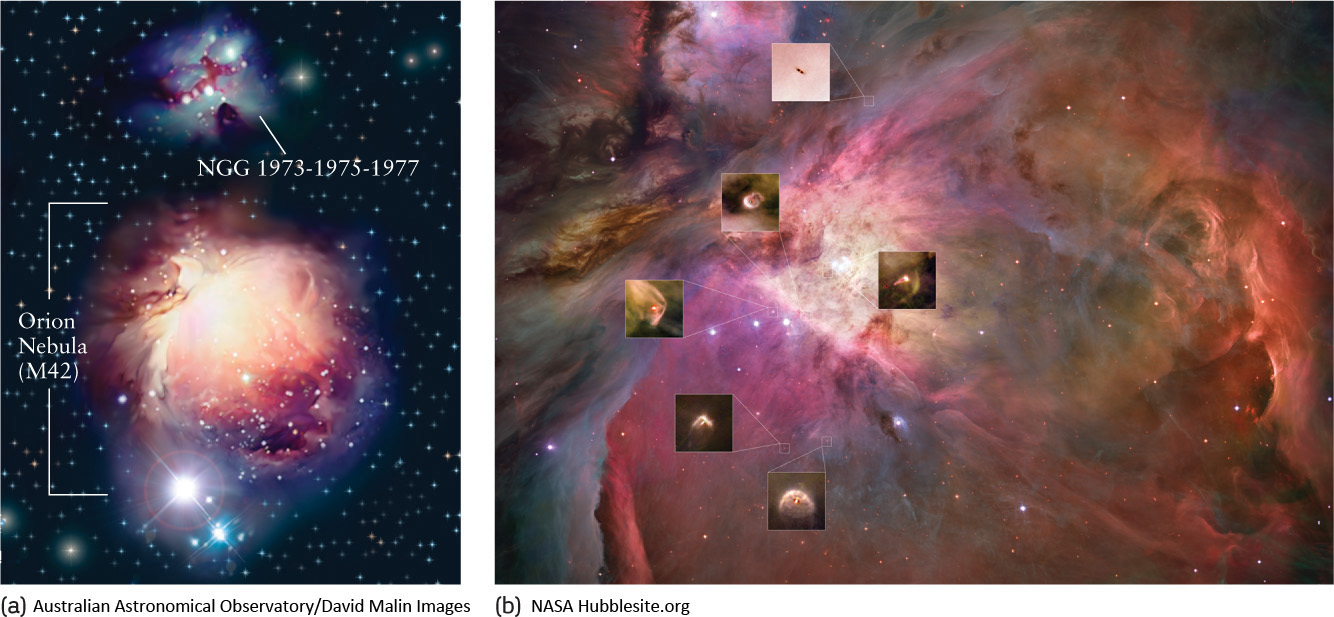
Question
ConceptCheck 4-12: If the nebular hypothesis is correct, what must it explain about the planetary orbits?
102